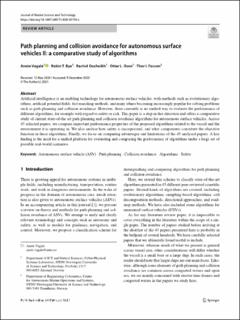| dc.contributor.author | Vagale, Anete | |
| dc.contributor.author | Bye, Robin Trulssen | |
| dc.contributor.author | Oucheikh, Rachid | |
| dc.contributor.author | Osen, Ottar | |
| dc.contributor.author | Fossen, Thor I. | |
| dc.date.accessioned | 2022-02-18T12:46:18Z | |
| dc.date.available | 2022-02-18T12:46:18Z | |
| dc.date.created | 2021-02-18T13:25:29Z | |
| dc.date.issued | 2021 | |
| dc.identifier.citation | Journal of Marine Science and Technology. 2021, . | en_US |
| dc.identifier.issn | 0948-4280 | |
| dc.identifier.uri | https://hdl.handle.net/11250/2980063 | |
| dc.description.abstract | Artificial intelligence is an enabling technology for autonomous surface vehicles, with methods such as evolutionary algorithms, artificial potential fields, fast marching methods, and many others becoming increasingly popular for solving problems such as path planning and collision avoidance. However, there currently is no unified way to evaluate the performance of different algorithms, for example with regard to safety or risk. This paper is a step in that direction and offers a comparative study of current state-of-the art path planning and collision avoidance algorithms for autonomous surface vehicles. Across 45 selected papers, we compare important performance properties of the proposed algorithms related to the vessel and the environment it is operating in. We also analyse how safety is incorporated, and what components constitute the objective function in these algorithms. Finally, we focus on comparing advantages and limitations of the 45 analysed papers. A key finding is the need for a unified platform for evaluating and comparing the performance of algorithms under a large set of possible real-world scenarios. | en_US |
| dc.language.iso | eng | en_US |
| dc.publisher | Elsevier | en_US |
| dc.rights | Navngivelse 4.0 Internasjonal | * |
| dc.rights.uri | http://creativecommons.org/licenses/by/4.0/deed.no | * |
| dc.title | Path planning and collision avoidance for autonomous surface vehicles II: a comparative study of algorithms | en_US |
| dc.type | Journal article | en_US |
| dc.type | Peer reviewed | en_US |
| dc.description.version | publishedVersion | en_US |
| dc.source.pagenumber | 17 | en_US |
| dc.source.journal | Journal of Marine Science and Technology | en_US |
| dc.identifier.doi | 10.1007/s00773-020-00790-x | |
| dc.identifier.cristin | 1891364 | |
| dc.relation.project | Norges forskningsråd: 2018-27 | en_US |
| dc.relation.project | Norges forskningsråd: 223254 | en_US |
| cristin.ispublished | true | |
| cristin.fulltext | original | |
| cristin.qualitycode | 2 | |

